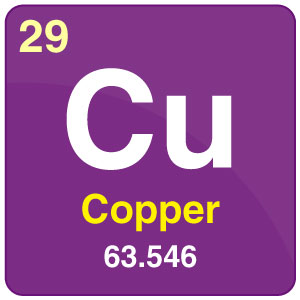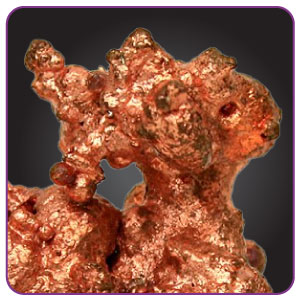
| Copper Symbol | Cu |
| Atomic Number of Copper | 29 |
| Atomic Mass of Copper | 63.546 g.mole-1 at 20°C |
| Discovered by | – |

Table of Contents
Chemical Properties Of Copper
| Group | 11 | Melting point | 1084.62°C, 1984.32°F, 1357.77 K |
| Period | 4 | Boiling point | 2560°C, 4640°F, 2833 K |
| Block | d | Density (g cm−3) | 8.96 |
| Atomic number | 29 | Relative atomic mass | 63.546 |
| State at 20°C | Solid | Key isotopes | 63Cu |
| Electron configuration | [Ar] 3d104s1 |
What is Copper?
Copper is a chemical element with atomic number 29 and symbol Cu. The Density of copper is 8.96. The atomic number of copper is 29.
- For thousands of years, Copper is a metal that has been a part of our civilization. Silver, gold, copper, and Iron all have been made use in one way or another.
- Copper(Cu) is one of those elements that were never actually discovered. They have been a part of each footstep in the growth of civilization. We keep on learning the diverse places where copper is made use of in nature.
- The metal has been used for such an extended time as it can be found secluded as an unadulterated element. One could be tunnelling in a mine and stumble across unadulterated copper in various forms.
- It is the 29th element in the periodic table represented by the symbol ‘Cu‘ short for the Latin name ‘cuprum’.
Copper is soft, but it is tough. It is easily mixed with other metals to form alloys such as bronze and bronze. Bronze is a tin and copper alloy, and brass is a zinc and copper alloy. Copper and brass are quickly recycled. Maybe 70% of the copper actually in use has been recycled at least once.
Density of Copper
The Density of copper is 8.96 g/cm3.
Density of a pure solid chemical element is always listed as the density of the equilibrium crystalline state of that element, usually at room temperature unless specified otherwise. This information must be borne in mind when considering the density for example, of copper which has an FCC crystal structure. The packing fraction for an FCC close-packed structure of hard spheres is 0.740. The slight discrepancy between the two methods of calculated [adding fractions is due to truncation and rounding off.
The density of copper in the amphorous solid state at room temperature can be predicted by the ratio of packing fraction. Copper is the most naturally occurring element other than gold with a distinctive hue. Unlike gold and silver, copper is a magnificent conductor of heat and electricity. It’s very malleable and ductile, too. Copper is also corrosion-resistant (it does not rust very easily).
Important Uses Of Copper
- Copper sulphate is used widely as an agricultural poison and as an algicide in water purification.
- While one may not consider copper being used for something other than coins, it is a crucial element in the creation of bronze.
- Historically, copper was the first metal to be worked by people. The discovery that it could be hardened with a little tin to form the alloy bronze gave the name to the Bronze Age.
- It is used for a whole range of goods, from cans, cooking foil and saucepans through to electricity cables, planes, and space vehicles.
- Electrical conductivity is especially important because wire accounts for more than 50% of copper consumption worldwide.
- Chemical vapour deposition, which is used in semiconductor manufacture, involves the deposition of thin copper films from a gas- phase precursor.
- Copper is used largely as an alloy of gold and silver, and it is often plated with one or the other.
Certain Facts About Copper
- Copper is an essential element. An adult human needs around 1.2 milligrams of copper a day, to help enzymes transfer energy in cells. Excess copper is toxic.
- In their scheme of hieroglyphs, the Egyptians used the ankh symbol to represent copper. Eternal life was also depicted.
- A copper earthing machine, as well as protecting homes and buildings that are destroyed by lightning strikes, may save the lives of people who are hit by lightning.
- For as long as we can recall, copper has been used. To represent copper, the Egyptians had the ankh symbol, and Egypt’s pyramids used copper for water plumbing.
- Naturally, copper is antibacterial. For public houses, brass doorknobs, handrails and finger plates are outstanding alternatives and can discourage bacteria from spreading.
Frequently Asked Questions – FAQs
What are the main uses of copper?
The primary applications of copper are in electrical wiring, roofing, plumbing, and industrial machinery. For most of these applications, copper is used in its pure form. However, it can be alloyed with other metals when increased levels of hardness are required. Copper wires are known to be used in power generation, power distribution, power transmission, and electronic circuits. In fact, more than half of all mined copper is used in electrical wiring.
Why is copper ideal for making wires?
Some desirable properties of copper that make it ideal for electrical wiring applications are:
- Copper, like most other metals, has very high electrical conductivity.
- The tensile strength exhibited by copper is also very good.
- Copper is a highly ductile metal, implying that it can easily be drawn into wires.
- Copper shows excellent resistance to deformation and creep.
- This metal is also highly resistant to corrosion.
- Copper also has very high thermal conductivity. This property, in combination with its low thermal expansion, makes it highly useful for wiring applications.
- The malleability of copper is another reason why it is preferred for the production of wires.
- Copper can also be easily soldered.
These properties of copper make it the ideal choice of metal for the production of electrical wires.
What is the electron configuration of copper?
The atomic number of copper is 29. The electronic configuration of copper can be written as [Ar]3d104s1. The electronic configuration of copper does not obey the Aufbau principle. This can be explained by the relatively low energy gap between the 3d and the 4s orbitals, and also by the added stability offered by a completely filled d-orbital.
What are the melting and boiling points of copper?
The melting point of copper is roughly equal to 1357.77 Kelvin, or 1084.62 degrees Celsius. The boiling point of copper is approximately equal to 2835 Kelvin, or 2562 degrees Celsius. Thus, it can be understood that copper (like most other metals) has a very high melting point and also a very high boiling point.
Why is copper denoted by the symbol ‘Cu’?
The symbol ‘Cu’ denotes the Latin name of copper, which is Cuprum. Copper can be classified as a native metal which can occur in nature in its pure form.
What are the effects of copper on humans?
Long-term exposure to copper can cause inflammation of the nose, throat, and eyes, causing headaches, stomach aches, dizziness, vomiting, and diarrhoea. Intensively high copper absorption can cause liver and kidney damage and even death. Whether copper is carcinogenic has not yet been determined.
Is Copper toxic to humans?
Copper is important to good health. However, exposure to higher doses may be harmful. Long-term exposure to copper dust may irritate your nose, mouth, and eyes, causing headache, dizziness, nausea, and diarrhoea. We don’t know whether copper can cause cancer in humans.
Why is copper so important?
Copper is a resource and an important part of our daily lives. This is a major industrial metal due to its high ductility, malleability, thermal and electrical conductivity and corrosion resistance. It’s an essential nutrient in our daily diet.

Nice
Important knowledge